Chinese Name: 首都博物馆 Pronunciation: Shǒudū Bówùguǎn
Building Time: 2001
Recommended Time for Visit: 3-4 Hours
Occupied Area: 24,800 square meters
Address: No. 16, Fuxingmen Outer St., Xicheng District, Beijing
Admission Ticket Fare: Free (You need to book a free ticket in advance.)
Building Function: A comprehensive exhibition hall to collect national heritages and to hold diverse heritage exhibition activities
Opening Time: 9:00-17:00 (The museum opens from Tuesday to Sunday(No admission after 16:00), and is closed on Mondays (Except for statutory holidays.)
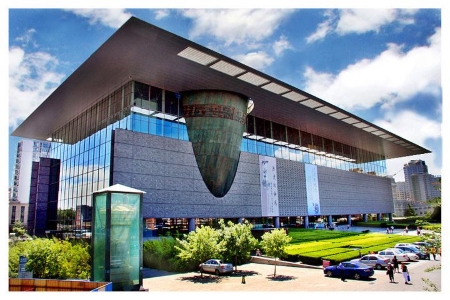
Completed in 2005, the Capital Museum is a large, comprehensive, and modern museum with a large number of collections, exhibitions, and magnificent architecture. The advanced technology improved its functions and could better protect its collections and serve visitors. Thus, taking full advantage of the location of Beijing as a cosmopolitan city, the Capital Museum has been known as a “first-class'” museum both at home and abroad.
The Capital Museum has a total area of 63,390 square meters and has a permanent exhibition collection of 5,622 items, including bronzes, ceramics, and Buddhist statues. The museum has become a comprehensive museum integrating collection, exhibition, research, archaeology, public education, and cultural exchange in Beijing.
In 1953, the museum started its preparatory work, and the site was set at the Confucius Temple on Guozijian Street.
In October 1981, the museum was officially opened to the public.
In 1999, to accommodate more collections, serve more visitors, and make the museum more functional, the museum applied for a new construction project as a key cultural construction project in Beijing, which was approved by the Beijing Municipal Government.
On May 18, 2006, the new museum was officially opened to the public.
On May 24, 2007, the museum was awarded the title “National Heritage System Advanced Collective of Cultural Relics System”.
On November 7, 2020, the branch of the museum in Longshan was officially established.
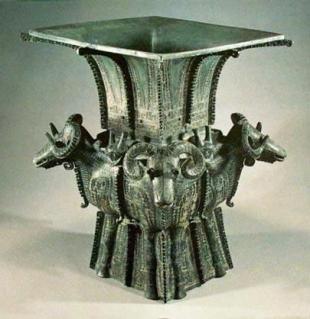
This artifact, dating back to the medium-term of Shang Dynasty (1600 BC -1046 BC), was excavated in 1977 from Liujiahe Tomb in Pinggu District, Beijing, and is 27 cm in height and 20 cm in diameter. In terms of appearance, this vessel has a high neck and curved shoulders. The acute angle between the shoulder and the body of the vessel is flanked by three ram heads and three animal faces on the body. The face of the beast is divided by a vertical flange.
The shoulders, the round foot (a style of ceramic foot), and the narrow band above and below the main pedestal are all painted with eyes and spiral decoration (multiple patterns). The neck has no decoration other than two simple bowstring decorations. After the casting process, there are three openings left on the round foot.
This artifact highlights the characteristics of the medium-term of Shang Dynasty, with an overall heavy shape and exquisite and delicate decoration. The ram heads on the shoulder of the pottery were cast by the split-casting method, thus showing the high skill of bronze casting technology and the wisdom of the ancient working people in the Beijing area during the Shang Dynasty.
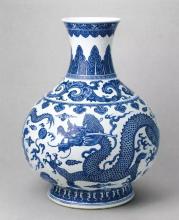
This Zun is from the Yongzheng period (1723-1735) of the Qing Dynasty and is 57 cm in height with a lid and 19.8 cm in inner diameter. The shape of this Zun is similar to that of a beaker, with a rectangular shape, a wide flared mouth as a trumpet, a contracted neck, a contracted neck, a bulging belly, and a round foot. Its mouth is decorated with the sea and S-shaped cloud symbolizing good fortune.
Two flying dragons are painted around the main body, with their heads and tails closely connected in an exquisite and lifelike technique. At the bottom of this Zun, there are double rows of blue and white regular script characters “Made during the Yongzheng period of the Qing Dynasty”. Its overall shape is delicate and beautiful, the brushwork is unique and refined, and the pattern is lifelike and beautifully white.
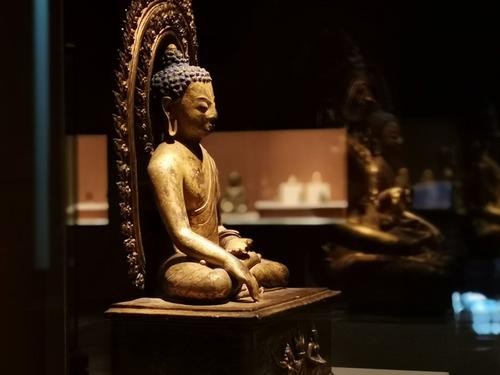
This statue, with a gilded copper surface, dates from the Tubo partition period (10th-13th centuries) and is 18.5 cm tall. After the early period of Tibetan Buddhism, Nepalese Buddha statue art continued to develop and spread in the Tibetan region.
During this period, the art of Nepalese Buddha statues had entered a comprehensive stage of maturity, with lifelike statues, beautiful postures, and simple clothing patterns. Most of them were cast in red bronze, with delicate and meticulous casting techniques, mostly using large lotus petals to decorate the rosettes. Their generous and simple shapes highlight the high level of exquisite craftsmanship. The characteristics of the Nepalese Buddhist style of this period are perfectly reflected by these statues, represented by the Statue of Sakyamuni.
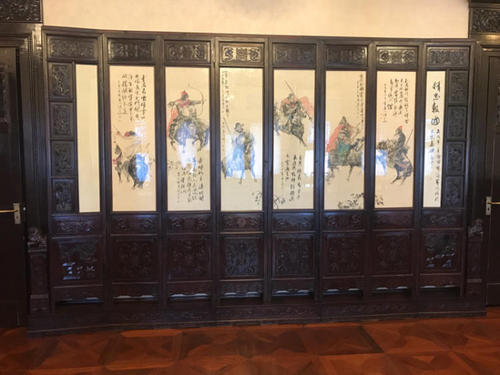
The jade table screen was a very popular interior decoration during the Qing Dynasty, mainly carved in incised lines and relief, and generally embedded in the upper end of the wooden seats. This table screen is 21.6 cm in diameter, and the patterns on both sides are carved in multi-layered relief technique, which is exquisite and chic.
One side of the screen is carved with a long gallery, plantain, cinnamon, table, bench, and figures, while the other side is carved with the landscape, weeping willow, boat, and figures. The overall carving technique adopts the method of distant mountains and near scenes, so the sense of gradation is distinct, and the workmanship is fine and well-polished.
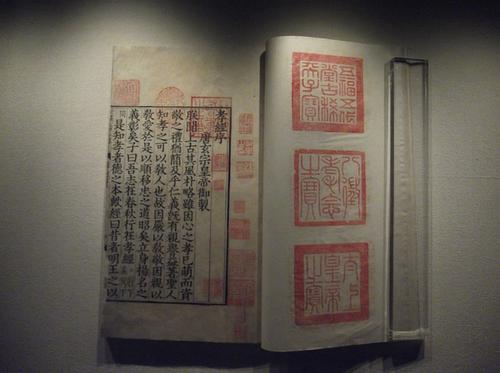
This calligraphic work was created in the Jin Dynasty (265-420) and measures 27 cm in height and 89.4 cm in length. The Classic of Filial Piety was written around the 3rd century B.C. and contains 18 chapters. The transcript is the second half of the Classic of Filial Piety, written during the Western Jin Dynasty. It is the earliest of all the ancient transcriptions of the Classic of Filial Piety known till now.
Its text contains only a few interchangeable and variant characters and is largely consistent with the commentaries and interpretations of the Thirteen Classics. Although the transcript has been slightly damaged, the ink on the paper still glows. The end of the transcript carries a colophon that indicates the name of the calligrapher and the date of completion.
Its script style is a hybrid of the clerical script and the regular script, employing strokes such as heng (horizontal strokes to the right) and pie charts (a throw falling leftwards with a slight curve), leaning towards that of the clerical script. With a refined technique, Zhang Jun, the calligrapher succeeded in conveying the rigorous and archaic qualities of the art of calligraphy.
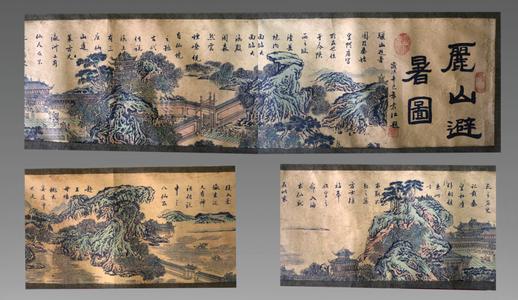
This painting titled Escaping the Summer Heat at Mount Li was created during the Qing Dynasty, with a height of 224 cm and a length of 134 cm. The author of this painting is Yuan Jiang (? - 1746), who styled himself as “Wentao”, and he was a native of Yangzhou, Jiangsu Province. Yuan was a famous master of jiehua (painting executed with measuring devices such as ruled lines) in the Qing Dynasty, specializing in landscape, flowers, and birds, with a neat and exquisite brushwork, a rigorous architectural structure, bright colors, and an opulent style.
This painting was completed in the 41st year (1702) of Kangxi Period of the Qing Dynasty, and the inspiration was from the stories of Emperor Xuanzong of the Tang Dynasty (618-907) who spent his holidays at the summer resort-Mountain Li, which is now in Lintong District, Xi’an, Shaanxi Province. Throughout the picture, Yuan reproduced the intricate scenes of history. Lush trees are scattered among the rugged rocks, and a lake flows at the foot of the mountain, meeting the misty sky in the distance. A section of stepping stones leads to the main building in the picture-that is the secluded and imposing Jiucheng Palace.
The entire painting has an imposing background, with pavilions and towers delicately embedded in the painting, thus bringing out the grandeur of the summer resort. The palace attendants dressed in brilliant colors, the jagged rocks, and the starry emerald trees also bring this masterpiece to life.
This funeral mask dates back to the Liao Dynasty (907-1125) and was unearthed in Fangshan District, Beijing, and is 31 cm long and 22.2 cm wide. The funerary mask, commonly known as the face cover, is a funerary tool of the Khitan nobles (The Khitan are descendants of the Donghu people, originating from the Xianbei clan, an ancient Chinese minority). The face mask was intended to protect the face of the deceased. Covering the face of the deceased with a metal mask was a rather unique burial custom of the Khitan people. According to historical records, the Khitan aristocracy had the funeral customs of “gold and silver masks to cover the face and copper wire to envelop their hands and feet”.
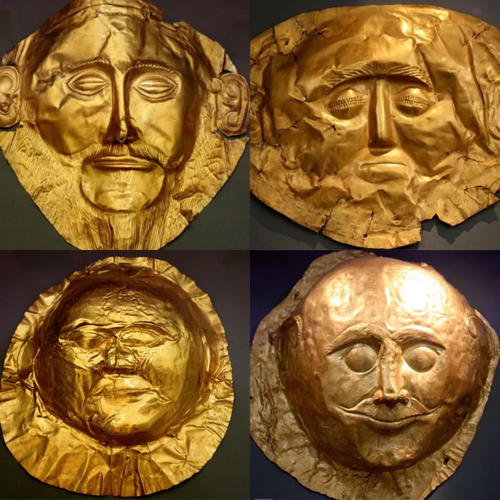
The masks were made of gold and silver to distinguish the social status, identity, age, and gender of the deceased. This mask is well preserved, and has a clear facial outline, with the hair pulled back, protruding eyebrow bones, closed eyes, and tightly closed lips, making a kind of peaceful demeanor. There are holes under the ears and on both sides of the temples for tying knots. From the image of the mask, it has the characteristics of ancient northern minorities in China.
Two theories have been proposed by scholars regarding the burial practices of the deceased Khitan wearing metal masks, one seeing the influence of shamanism and the other Buddhism. Some researchers support the former theory. They argue that the deceased wore Khitan masks to fulfill the special mission of shamans in communicating between humans and gods.
Meanwhile, those who favor the latter theory believe that since most metal masks are very similar in shape to the Buddha statues created during the Liao Dynasty. They also believe that the flourishing Buddhism of the time must have had some influence on the development of metal masks. However, recent research suggests that the metal masks depict the facial features of deceased nobles of the Liao Dynasty and are intended to show reverence and worship for their ancestors. In conclusion, the study of Khitan metal masks is developing and deepening.
1. Inebriated and improperly-dressed persons will be refused to enter.
2. Inflammable and explosive materials, knives and dangerous articles cannot be brought into the museum.
3. Photography is permitted, but flash and tripod are not allowed.
4. In case of an emergency, please follow the directions of the museum staff.
Take bus 1 or 52 and get off at Gonghui Dalou Station.And then walk westward for 150 meters along the Fuxingmen Outer St., go across the road and turn left into Baiyunlu(Baiyun Road), walk 90 meters to the destination.
Take bus 52, 114, or 308 and get off at Muxidi East Station. And then walk eastward for about 540 meters along the Fuxingmen Outer St., turn right into Baiyunlu(Baiyun Road), walk 80 meters to the Capital Museum.
Take bus 1, 10, or 52, and get off at Nanlishi Road Station. And then walk 550 meters along the Nanlishilu(Nanlishi Road), go across the road and turn left into Baiyunlu(Baiyun Road), walk 80 meters to the destination.
Take Metro Line 1 and get off at Muxidi Station (Exit C1), and then walk to the destination(same with the second walking route by bus ).
Chinese: 请带我去首都博物馆。English: Please take me to the Capital Museum.
If you go to the Capital Museum from the center of Beijing (Grand Hyatt Beijing), it takes about 30 minutes (about 35 yuan).
If you go to the Capital Museum from Beijing Capital International Airport, it takes about 1 hour (about 130 yuan).
If you go to the Capital Museum from Beijing Daxing International Airport, it takes about 1 hour (about 180 yuan).
If you go to the Capital Museum from Beijing West Train Station, it takes about 10 minutes (about 15 yuan).
